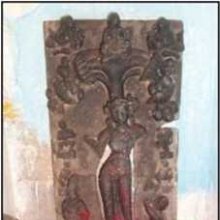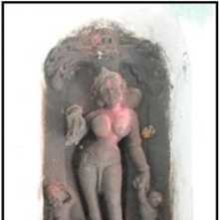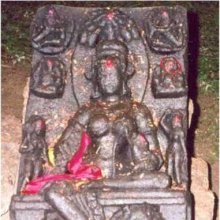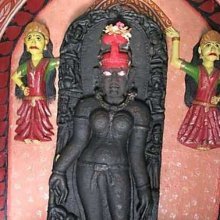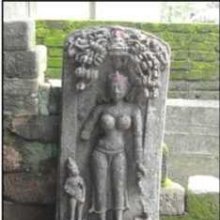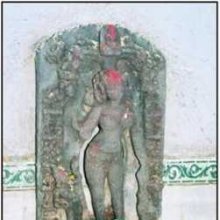Ambika, Aṃbikā, Ambikā: 29 definitions
Introduction:
Ambika means something in Buddhism, Pali, Hinduism, Sanskrit, Jainism, Prakrit, biology. If you want to know the exact meaning, history, etymology or English translation of this term then check out the descriptions on this page. Add your comment or reference to a book if you want to contribute to this summary article.
Images (photo gallery)
(+47 more images available)
In Hinduism
Shaivism (Shaiva philosophy)
Source: Wisdom Library: Kubjikāmata-tantra1) Ambikā (अम्बिका):—One of the twelve guṇas associated with Piṇḍa, the seventh seat of the Svādhiṣṭhāna-chakra. According to tantric sources such as the Śrīmatottara-tantra and the Gorakṣasaṃhitā (Kādiprakaraṇa), these twelve guṇas are represented as female deities. According to the Ṣaṭsāhasrasaṃhitā however, they are explained as particular syllables. They (e.g. Ambikā) only seem to play an minor role with regard to the interpretation of the Devīcakra (first of five chakras, as taught in the Kubjikāmata-tantra).
2) Ambikā (अम्बिका):—Sanskrit name of one of the twenty-four goddesses of the Sūryamaṇḍala (first maṇḍala of the Khecarīcakra) according to the kubjikāmata-tantra. The Khecarīcakra is the fifth cakra (‘internal mystic center’) of the five (pañcacakra) and is located on or above the head. She presides over the pītha (‘sacred site’) called Virajā.
Source: Wisdom Library: ŚaivismAmbikā (अम्बिका) is a Sanskrit word referring to one of the sixty-eight places hosting a svāyambhuvaliṅga, one of the most sacred of liṅgas according to the Śaivāgamas. The presiding deity residing over the liṅga in this place (Ambikā) is named Umāpati. The list of sixty-eight svāyambhuvaliṅgas is found in the commentary of the Jirṇoddhāra-daśaka by Nigamajñānadeva. The word liṅga refers to a symbol used in the worship of Śiva and is used thoughout Śaiva literature, such as the sacred Āgamas.
Source: Shodhganga: Iconographical representations of ŚivaAmbikā (अम्बिका) is the name of a deity who received the Cintyāgama from Gopati who in turn, received it from Sudīpta through the mahānsambandha relation, according to the pratisaṃhitā theory of Āgama origin and relationship (sambandha). The cintya-āgama, being part of the ten Śivabhedāgamas, refers to one of the twenty-eight Siddhāntāgamas: a classification of the Śaiva division of Śaivāgamas. The Śaivāgamas represent the wisdom that has come down from lord Śiva, received by Pārvatī and accepted by Viṣṇu.
Ambikā obtained the Cintyāgama from Gopati who in turn obtained it from Sudīpta who in turn obtained it from Sadāśiva through parasambandha. Ambikā then, through divya-sambandha transmitted it to the Devas who, through divyādivya-sambandha, transmitted it to the Ṛṣis who finally, through adivya-sambandha, revealed the Cintyāgama to human beings (Manuṣya). (also see Anantaśambhu’s commentary on the Siddhāntasārāvali of Trilocanaśivācārya)
Source: academia.edu: A Critical Study of the Vajraḍākamahātantrarāja (II) (shaivism)Ambikā (अम्बिका) is the name of a Goddess (Devī) presiding over Virajā: one of the twenty-four sacred districts mentioned in the Kubjikāmatatantra (chapter 22). Her weapon is the mudrā and paṭṭiśa. Furthermore, Ambikā is accompanied by the Kṣetrapāla (field-protector) named Anala. A similar system appears in the 9th century Vajraḍākatantra (chapter 18).

Shaiva (शैव, śaiva) or Shaivism (śaivism) represents a tradition of Hinduism worshiping Shiva as the supreme being. Closely related to Shaktism, Shaiva literature includes a range of scriptures, including Tantras, while the root of this tradition may be traced back to the ancient Vedas.
Shaktism (Shakta philosophy)
Source: Wisdom Library: Śāktism1) Ambikā (अम्बिका, “mother”):—Name of one of the sixty-four mātṛs to be worshipped during Āvaraṇapūjā (“Worship of the Circuit of Goddesses”, or “Durgā’s Retinue”), according to the Durgāpūjātattva. They should be worshipped with either the five upācāras or perfume and flowers.
Her mantra is as follows:
ॐ अम्बिकायै नमः
oṃ ambikāyai namaḥ.
2) Ambikā (अम्बिका, “the mother”).—One of the names of the Goddess, Devī, who is regarded as the female principle of the divine; the embodiement of the energies of the Gods.
Source: Google Books: Manthanabhairavatantram1) Ambikā (अम्बिका) refers to the Goddess (Śakti) (of the second of seven births before attaining liberation) according to the Janmasūtra.—The six beginning with the Buddhists and ending with the Śaivites are in the fettered state (paśubhāva). The seventh that has come into being is the House (veśman) of the Yoginī whose sign is liberation. In the first one Tārā is the goddess (śakti) and Ambikā in the second. Gāyatrī is (the form of the goddess) in the third (birth) and Lakṣmī in the fourth. In the fifth she is Rājñī and is said to be Umā in the sixth. In the seventh she is Khañjī who has descended in each Age.
2) Ambikā (अम्बिका) refers to “mother”, according to the second recension of the Yogakhaṇḍa of the Manthānabhairavatantra, a vast sprawling work that belongs to a corpus of Tantric texts concerned with the worship of the goddess Kubjikā.—Accordingly, as the Goddess Kumārī said to Ṛṣi Vyāsa said: “Vyāsa’s state is nothing (real). O Śaṃkara, (there is nothing) of mine (I can give) you. [...] And (there is) Māyā in the form of one's sister and she is (one’s) daughter due to Māyā. And that pure mother [i.e., ambikā—māyāmbikā śuddhā] is Māyā. Another Māyā is the (liberating) sixteenth energy (of the moon). [...]”.
3) Ambikā (अम्बिका) refers to one of the thirty-two Bhairavīs (also Dūtis) embodying the syllables of the goddess’s Vidyā, according to the Manthānabhairavatantra,.—The thirty-two Bhairavīs [i.e., Ambikā] are the consorts of the Bhairavas presiding over the sonic energies of the thirty-two syllables of her Vidyā.
Source: Sreenivasarao's blog: Saptamatrka (part 4)Ambika or Kaumari refers to one of the seven mother-like goddesses (Matrika).—The Matrikas emerge as shaktis from out of the bodies of the gods: Kaumari from Skanda. The order of the Saptamatrka usually begins with Brahmi symbolizing creation. Then, Vaishnavi and Maheshvari. Then, Kaumari, Guru-guha, the intimate guide in the cave of one’s heart, inspires aspirations to develop and evolve.

Shakta (शाक्त, śākta) or Shaktism (śāktism) represents a tradition of Hinduism where the Goddess (Devi) is revered and worshipped. Shakta literature includes a range of scriptures, including various Agamas and Tantras, although its roots may be traced back to the Vedas.
Purana and Itihasa (epic history)
Source: archive.org: Puranic Encyclopedia1) Ambikā (अम्बिका).—Elder sister of Ambālikā. (See AMBĀLIKĀ).
2) Ambikā (अम्बिका).—Another name of Pārvatī. (Agni Purāṇa, Chapter 12).
Source: archive.org: Shiva Purana - English Translation1) Ambikā (अम्बिका) is another name for Śakti (prime cause, created from the body of Īśvara), according to Śivapurāṇa 2.1.6, while explaining the time of great dissolution (mahāpralaya):—“[...] this Śakti is called by various names. Pradhāna, Prakṛti, Māyā, Guṇavatī, Parā. The mother of Buddhi Tattva (The cosmic Intelligence), Vikṛtivarjitā (without modification). That Śakti is Ambikā, Prakṛti and the goddess of all. She is the prime cause and the mother of the three deities. [...]”.
2) Ambikā (अम्बिका) is an epithet of the Goddess (Devī), who incarnated as Satī, according to the Śivapurāṇa 2.2.14. Accordingly as Brahmā narrated to Nārada:—“[...] On seeing the mother of the universe born of Vīriṇī, Dakṣa joined his palms in reverence, paid respects to her and eulogised her. [...] O mother of the universe, those who eulogise Thee with the names of Bhavānī, Ambikā, Jaganmāyā and Durgā will have everything”.
Source: Cologne Digital Sanskrit Dictionaries: The Purana Index1a) Aṃbikā (अंबिका).—Wife of Śiva.1 Daughter of Dakṣa reborn of Menā.2 Pacified by Citraketu.3 Surname of Pārvati and Yogamāyā.4 Gave bhikṣā to Vāmana.5 In her honour a festival was celebrated at a sacred spot called Ambikāvana. In this Gopas participated.6 Represents Soma while Śiva is Agni.7 Worshipped in ceremonials before digging tanks.8
- 1) Bhāgavata-purāṇa III. 12. 13.
- 2) Ib. IV. 7. 59.
- 3) Ib. VI. 17. 17.
- 4) Ib. X. 2. 12.
- 5) Ib. VIII. 18. 17.
- 6) Ib. X. 34. 1-3.
- 7) Brahmāṇḍa-purāṇa II. 27. 112; IV. 14. 6; 15. 52; 44. 86.
- 8) Matsya-purāṇa 58. 26.
1b) A daughter of the King of Kāśi and wife of Vicitravīrya.1 Mother of Dhṛtarāṣṭṛa.2

The Purana (पुराण, purāṇas) refers to Sanskrit literature preserving ancient India’s vast cultural history, including historical legends, religious ceremonies, various arts and sciences. The eighteen mahapuranas total over 400,000 shlokas (metrical couplets) and date to at least several centuries BCE.
Kavya (poetry)
Source: archive.org: Naisadhacarita of SriharsaAmbikā (अम्बिका) refers to the nine Goddesses known as the Mātṛs, and is mentioned in the Naiṣadha-carita 7.98.—The poet refers to the nine Ambikās or the Goddesses more commonly known as the Mātṛs.

Kavya (काव्य, kavya) refers to Sanskrit poetry, a popular ancient Indian tradition of literature. There have been many Sanskrit poets over the ages, hailing from ancient India and beyond. This topic includes mahakavya, or ‘epic poetry’ and natya, or ‘dramatic poetry’.
Ayurveda (science of life)
Nighantu (Synonyms and Characteristics of Drugs and technical terms)
Source: WorldCat: Rāj nighaṇṭu1) Ambikā (अम्बिका) is another name for Ambaṣṭhā, an unidentified medicinal plant, according to verse 4.77-79 of the 13th-century Raj Nighantu or Rājanighaṇṭu. The fourth chapter (śatāhvādi-varga) of this book enumerates eighty varieties of small plants (pṛthu-kṣupa). Ambaṣṭhā is a highly controversial plant. Vaidyas use different plants at different places for this. The reason is the confused description of the drug by various authors. Together with the names Ambikā and Ambaṣṭhā, there are a total of sixteen Sanskrit synonyms identified for this plant.
2) Ambikā (अम्बिका) is also mentioned as a synonym for Śvetāmlī, an unidentified medicinal plant, according to verse 4.175. Together with the names Ambikā and Śvetāmlī, there are a total of four Sanskrit synonyms identified for this plant.

Āyurveda (आयुर्वेद, ayurveda) is a branch of Indian science dealing with medicine, herbalism, taxology, anatomy, surgery, alchemy and related topics. Traditional practice of Āyurveda in ancient India dates back to at least the first millenium BC. Literature is commonly written in Sanskrit using various poetic metres.
General definition (in Hinduism)
Source: Wisdom Library: Hinduism1) Ambikā (अम्बिका):—One of the daugthers of Kāśirāja, who, together with her sister named Ambālikā, were taken away by force and were married to by Vicitravīrya.
2) Ambika is one of the major rivers in the Indian state of Gujarat. The river has its origins in Saputara Hill ranges in the Nasik district of Maharashtra. Ambika has a drainage area of 2715 km2 and its travels 136 km before joining with Arabian sea.
Source: Apam Napat: Indian MythologyAmbika was the second of the Kashi princesses who were abducted by Bhishma to become the wives of his half-brother Vichitraveerya. However, the eldest Amba refused to marry him, on the plea that she was plighted to Shalwa and therefore only Ambika and Ambalika were married to Vichitraveerya.
Source: WikiPedia: Hinduism1) Ambikā (अम्बिका)—One of the eleven wives of Rudra, called a Rudrāṇī.
2) In the epic Mahabharata, Ambika (अम्बिका) is the daughter of Kashya, the King of Kashi, and wife of Vichitravirya, the king of Hastinapura. Along with her sisters Amba and Ambalika, she was taken by force by Bhishma from their Swayamvara. Bhishma challenged the assembled Kings and Princes and defeated them. He presented them to Satyavati for marriage to Vichitravirya. Vichitravirya married only Ambika and Ambalika, and refused to marry Amba since she had already given her heart to another.
Source: Oxford Index: Indian Culture1 Another name for the goddess Durgā. Iconographically, the name may be reserved for Durgā when she is seated on, or attended by, a lion or tiger. The name is also applied to Umā (Parvatī), and to goddesses in general.
2 A Jain attendant goddess, perhaps originally of independent status, who is attached to the Nemi, the twenty-second Jain tīrthaṅkara, and associated with childbirth and prosperity. Her mount is a lion.
3 Dhṛtarāṣṭra's mother in the Mahābhārata. She shut her eyes during intercourse with Vyāsa, hence her son was born blind.
In Buddhism
Tibetan Buddhism (Vajrayana or tantric Buddhism)
Source: academia.edu: A Critical Study of the Vajraḍākamahātantrarāja (II)Ambikā (अम्बिका) is the name of a Goddess (Devī) presiding over Virajā: one of the twenty-four sacred districts mentioned in the 9th century Vajraḍākatantra (chapter 18). Her weapon is the mudrā and paṭṭiśa. Furthermore, Ambikā is accompanied by the Kṣetrapāla (field-protector) named Anala and their abode is the āmra-tree.

Tibetan Buddhism includes schools such as Nyingma, Kadampa, Kagyu and Gelug. Their primary canon of literature is divided in two broad categories: The Kangyur, which consists of Buddha’s words, and the Tengyur, which includes commentaries from various sources. Esotericism and tantra techniques (vajrayāna) are collected indepently.
In Jainism
General definition (in Jainism)
Source: archive.org: The Jaina IconographyAmbikā (अम्बिका) (or Kuṣmāṇḍinī, Kuṣmāṇḍī, Āmrā) is the name of the Yakṣiṇī accompanying Neminātha: the twenty-second of twenty-four Tīrthaṃkaras or Jinas, commonly depicted in Jaina iconography.—Neminātha’s emblem is known to be a conch-shell from the Jaina canonical texts. The Śāsana-devatās who attend upon him are Yakṣa Gomedha and Yakṣiṇī Ambikā (Digambara: and Kuṣmāṇḍinī). The Chowri-bearer, in his case, is King Ugrasena. His Kevala-tree is called Mahāveṇu or Vetasa.
This Yakṣiṇī of Neminātha has the Śvetāmbara description of a Goddess, who rides a lion and bears a bunch of mangoes, nose, a child and goad. The Digambara image of the Yakṣiṇī is described as also riding upon a lion, but as bearing two hands with a bunch of mangoes and a child.
Source: WikiPedia: JainismIn Jainism, Ambika is the Yakṣi "dedicated attendant deity" or Śāsana Devī "protector goddess" of the 22nd Tirthankara, Neminath. She is also known as Ambai, Amba and Amra Kushmandini. According to the tradition, her colour is golden and her vehicle is lion. She has four arms. In her two right hands she carries a mango and in the other a branch of a mango tree. In one of her left hands, she carries a rein and in the other she has her two sons, Priyankara and Shubhankara.
etymology: Ambika (Sanskrit: अम्बिका, Oriya: ଅମ୍ବିକା Ambikā "Mother") or Ambika Devi (अम्बिका देवी Ambikā Devī "the Goddess-Mother")

Jainism is an Indian religion of Dharma whose doctrine revolves around harmlessness (ahimsa) towards every living being. The two major branches (Digambara and Svetambara) of Jainism stimulate self-control (or, shramana, ‘self-reliance’) and spiritual development through a path of peace for the soul to progess to the ultimate goal.
Biology (plants and animals)
Source: Wisdom Library: Local Names of Plants and DrugsAmbika [अम्बिका] in the Sanskrit language is the name of a plant identified with Hibiscus cannabinus L. from the Malvaceae (Mallow) family. For the possible medicinal usage of ambika, you can check this page for potential sources and references, although be aware that any some or none of the side-effects may not be mentioned here, wether they be harmful or beneficial to health.
Source: Google Books: CRC World Dictionary (Regional names)Ambika in India is the name of a plant defined with Hibiscus cannabinus in various botanical sources. This page contains potential references in Ayurveda, modern medicine, and other folk traditions or local practices It has the synonym Abelmoschus verrucosus (Guill. & Perr.) Walp. (among others).
Example references for further research on medicinal uses or toxicity (see latin names for full list):
· Botanical Register (1825)
· Supplementum ad Methodum Plantas (1802)
· Bulletin de la Société Impériale des Naturalistes de Moscou (1858)
· Annuaire du Conservatoire et Jardin Botaniques de Genève (1901)
· Annuaire du Conservatoire et Jardin Botaniques de Genève (1900)
· Systema Naturae
If you are looking for specific details regarding Ambika, for example chemical composition, diet and recipes, health benefits, extract dosage, pregnancy safety, side effects, have a look at these references.

This sections includes definitions from the five kingdoms of living things: Animals, Plants, Fungi, Protists and Monera. It will include both the official binomial nomenclature (scientific names usually in Latin) as well as regional spellings and variants.
Languages of India and abroad
Sanskrit dictionary
Source: DDSA: The practical Sanskrit-English dictionaryAmbikā (अम्बिका).—
1) A mother, good woman, also used like अम्बा (ambā) as a term of respect or endearment; अत्तिके अम्बिके शृणु मम विज्ञप्तिम् (attike ambike śṛṇu mama vijñaptim) Mṛcchakaṭika 1.
2) Name of a plant (ambā 2); Name of another plant कटुकी (kaṭukī).
3) Name of Pārvatī, wife of Śiva; आशीर्भिरेधयामासुः पुरः पाकाभिरम्बिकाम् (āśīrbhiredhayāmāsuḥ puraḥ pākābhirambikām) Kumārasambhava 6.9.
4) Name of the middle daughter of Kāśīrāja and the eldest wife of Vichitravīrya. Like her youngest sister she had no progeny, and Vyāsa begot on her a son named धृतराष्ट्र (dhṛtarāṣṭra).
5) Name of a Jaina deity.
Source: Cologne Digital Sanskrit Dictionaries: Shabda-Sagara Sanskrit-English DictionaryAmbikā (अम्बिका).—f.
(-kā) 1. A mother. 2. A name of Parvati. 3. The mother of D'Hritarashtra. 4. One of the female. domestic deities of the Jainas. 5. A medicinal plant. See kaṭukī. E. ambā a mother, and kan affix; like a mother.
Source: Cologne Digital Sanskrit Dictionaries: Cappeller Sanskrit-English DictionaryAmbikā (अम्बिका).—[feminine] the same; [Name] of a princess.
Source: Cologne Digital Sanskrit Dictionaries: Monier-Williams Sanskrit-English Dictionary1) Ambika (अम्बिक):—[from ambā] m. Name of a man, [Kāṭhaka; Anukramaṇikā]
2) Ambikā (अम्बिका):—[from ambā] f. ([vocative case] ambike), mother, good woman (as a term of respect), [Vājasaneyi-saṃhitā] and, [Taittirīya-saṃhitā] (cf. [Pāṇini 6-1, 118]), [Pāṇini 7-3, 107] [commentator or commentary] ([vocative case] ke) and, [Kāśikā-vṛtti] (in Veda [vocative case] optionally ka and ke)
3) [v.s. ...] a Name applied to the harvest (as the most productive season), [Kāṭhaka]
4) [v.s. ...] a sister of Rudra, [Vājasaneyi-saṃhitā; Śatapatha-brāhmaṇa]
5) [v.s. ...] Name of Pārvatī (the wife of Śiva), [Harivaṃśa; Yājñavalkya] etc.
6) [v.s. ...] of the wife of Rudra Ugraretas, [Bhāgavata-purāṇa]
7) [v.s. ...] of one of the mothers in Skanda’s retinue, [Mahābhārata ix, 2630]
8) [v.s. ...] of a daughter of the king of Kāśi (wife of Vicitravīrya, and mother of Dhṛtarāṣṭra), [Mahābhārata] etc. (cf. ambālikā)
9) [v.s. ...] one of the female domestic deities of the Jainas, [cf. Lexicographers, esp. such as amarasiṃha, halāyudha, hemacandra, etc.]
10) [v.s. ...] Name of a place in Bengal, [cf. Lexicographers, esp. such as amarasiṃha, halāyudha, hemacandra, etc.]
11) [v.s. ...] Name of two rivers, [Hemādri’s Caturvarga-cintāmaṇi]
12) [v.s. ...] the plant Wrightia Antidysenterica.
Source: Cologne Digital Sanskrit Dictionaries: Yates Sanskrit-English DictionaryAmbikā (अम्बिका):—(kā) 1. f. Idem.
Source: DDSA: Paia-sadda-mahannavo; a comprehensive Prakrit Hindi dictionary (S)Ambikā (अम्बिका) in the Sanskrit language is related to the Prakrit word: Aṃbiā.
[Sanskrit to German]
Sanskrit, also spelled संस्कृतम् (saṃskṛtam), is an ancient language of India commonly seen as the grandmother of the Indo-European language family (even English!). Closely allied with Prakrit and Pali, Sanskrit is more exhaustive in both grammar and terms and has the most extensive collection of literature in the world, greatly surpassing its sister-languages Greek and Latin.
See also (Relevant definitions)
Starts with (+4): Ambika-janika, Ambikabharta, Ambikadvirupanamadhyana, Ambikahridaya, Ambikai, Ambikakhanda, Ambikamahatmya, Ambikaparinaya, Ambikapati, Ambikaprasada, Ambikaputra, Ambikaramana, Ambikarcanacandrika, Ambikashraya, Ambikasuta, Ambikavana, Ambikayoga, Ampikai, Ampikaimalai, Ampikaitanayan.
Ends with (+22): Avalambika, Bhavambika, Bhukadambika, Cambika, Chhidralambika, Chidralambika, Dambika, Dighalambika, Ganambika, Jagadambika, Jalambika, Kadambika, Kalambika, Kambika, Kaushambika, Kosambika, Kujambika, Kulambika, Lambika, Madambika.
Full-text (+119): Ambalika, Amba, Jalambika, Vicitravirya, Dhritarashtra, Ambikeya, Ambikasuta, Ambikaputra, Ambikapati, Jagadambika, Ambikavana, Ambaka, Ambikaparinaya, Vidura, Ambikamahatmya, Ambikakhanda, Anala, Kushmandini, Viraja, Cekatampikai.
Relevant text
Search found 65 books and stories containing Ambika, Aṃbikā, Ambikā; (plurals include: Ambikas, Aṃbikās, Ambikās). You can also click to the full overview containing English textual excerpts. Below are direct links for the most relevant articles:
The Markandeya Purana (Study) (by Chandamita Bhattacharya)
3. Birth of Ambikā / Kauśikī out of Pārvati’s body < [Chapter 3]
4. Birth of Kālī from Ambikā’s Forehead < [Chapter 3]
Śakti Mythology (Introduction) < [Chapter 3]
Rudra-Shiva concept (Study) (by Maumita Bhattacharjee)
2.19. Rudra as Tryambaka < [Chapter 6a - The Epithets of Rudra-Śiva]
8. Rudra and Ambikā < [Chapter 3 - Rudra-Śiva in the Brāhmaṇa Literature]
1. Rudra-Śiva In The Āraṇyaka Literature < [Chapter 4 - Rudra-Śiva in the Post-Brāhmaṇic Literature]
Cidgaganacandrika (study) (by S. Mahalakshmi)
Verse 12 [Ambika is Kilāsa] < [Chapter 1 - First Vimarśa]
Verse 11 [Ambikā, the aggregate form of Pañca Śakti] < [Chapter 1 - First Vimarśa]
Verse 32 [Revelation of Īśvara] < [Chapter 2 - Second Vimarśa]
Preceptors of Advaita (by T. M. P. Mahadevan)
The Linga Purana (by J. L. Shastri)
Chapter 87 - Suppression of delusion (muni-moha-śamana) < [Section 1 - Uttarabhāga]
Chapter 105 - The origin of Vināyaka < [Section 1 - Uttarabhāga]
Chapter 27 - The description of the Jaya ablution < [Section 2 - Pūrvabhāga]
The Skanda Purana (by G. V. Tagare)
Chapter 13 - The Glory of Svargadvāra < [Section 1 - Avantīkṣetra-māhātmya]
Chapter 119 - Greatness of Balātibaladaityaghnī (Bala-Atibala-daitya-ghnī) < [Section 1 - Prabhāsa-kṣetra-māhātmya]
Chapter 4 - Pārvatī Goes to the Hermitage of Gautama < [Section 3a - Arunācala-khaṇḍa (Pūrvārdha)]
Related products
